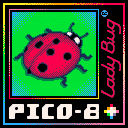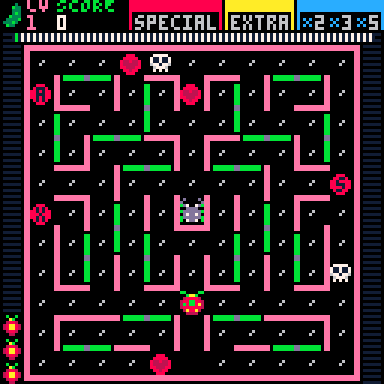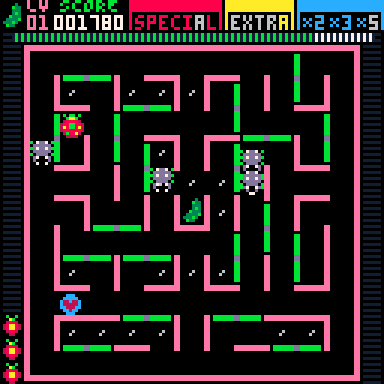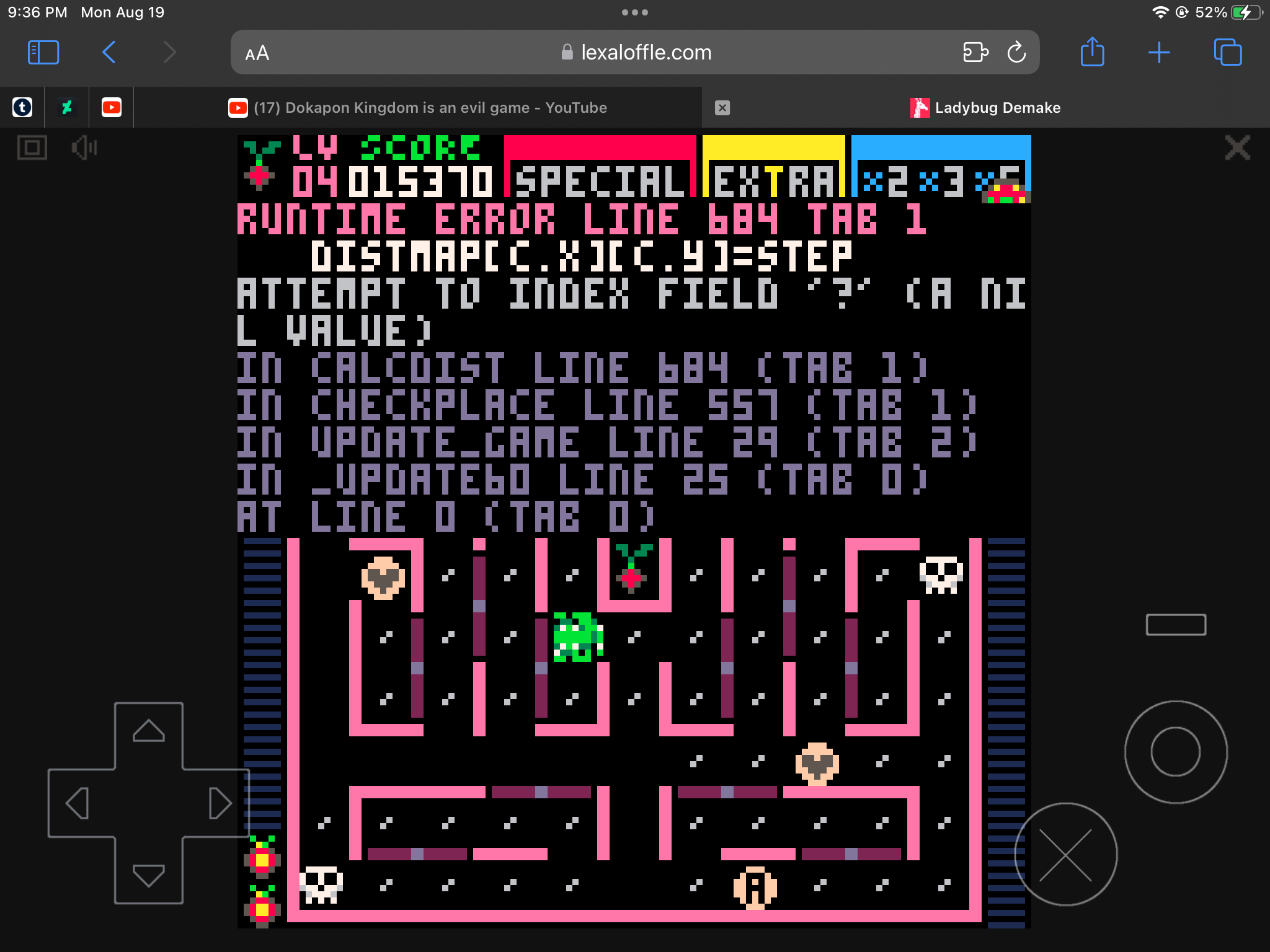

How to Play
Use the directional keys to move the “Lady Bug” 🐞 and eat all the white seeds (dots) on the course.
Don’t let the 🐞 be eaten by the predatory “Enemy Bugs” 🪲 that chase the 🐞 around the screen. Use the turnstiles to allow the 🐞 to dodge the 🪲.
The 🪲 cannot turn the turnstiles. If the 🪲 hits a 💀, it disappears and is sent back to the bug box in the center of the coarse.
When the 🐞 hits the skull 💀 or is eaten up by a 🪲 , it disappears.
When players lose all the 🐞, the game is over.

Scoring
The scores awarded when various things are eaten up by the players’ 🐞 are as follows :
Seeds
10 points
Feature
🔵 100 points when blue
🟡 300 points when yellow
🔴 800 points when red
Vegetable
🥕 1000 - 9500 points
🥒1000 … 🍆1500 … 🥕2000 … ?

Features
SPECIAL
When all S-P-E-C-I-A-L letters (red) have been eaten up, players are awarded a Vegetable Harvest bonus stage.
EXTRA
When all E-X-T-R-A letters (yellow) have been eaten up, another 🐞 is awarded.
BONUS
Each time the blue 💙 is eaten on a level, the point values multiplies by X2, X3, X5. The bonus resets at the beginning of each level.
Did you know?...

Fact: when you press z, you will be awarded an extra ladybug. And in the second run it has the syntax error.

@Ben731985 Whoops! I had forgotten to turn the testing functions off. Fixed now, thank you for the feedback! :)

I have some suggestions:
Maybe it is a good idea, the lady bug stop only on complete tiles and not between. Its way it is easier to move around corners or t-turns.
the enemies often move up/down between two tiles and so there are really static on the screen. I would suggest, that you should forbid uturns, so for example when a bug is moved down, it should never go up. Only if the bug is in an dead end and has no choice, it is allowed to go back.
Maybe a problem could be, that than the enemies bugs stack together, something like this could solved, when two enemies touch each other, they can go to random direction on the next waypoint.
At the moment I had the big problem, that i need the seed it the middle and the enemies don't move outside this area.

Awesome port!
I even checked if you implemented some details/rules likely to be missed and they're there 👌
E.g. my first check: in the same stage, after eating the fruit, the insects are frozen for a short time; if a skull is still in the maze and one insects dies it respawns leaving a second fruit. Great job 👍

@GPI Good suggestions! There is some code in there which helps ease the player onto an intersection (autocorrecting their X/Y position from as many as 3 pixels away) so some form of intersection help already exists already within the game. This game was originally an arcade game and the ability to accidentally bonk into a wall was definitely in the original so it wasn't removed here, but your idea would certainly make a similar game better. The up and down movement of the enemy bugs mimics the behavior in the original as well.
The problem of needing seeds in the center when bugs are there is definitely a thing, especially in the Colecovision version. You can attempt to draw off the bugs by moving to the opposite corner of the board and swinging back to the center, and strategy guides encourage clearing out the center first in order to help clear the board. As noted, the original game had an additional pathfinding function which this current build does not have which would have drawn out the bugs a bit more, having them home in directly on your position.
@Heracleum Thank you!! :) I tried to cover everything I could find - it has a LOT of rules! I can definitely see why Universal's follow up game, Mr. Do! did away with many of them. The only part of the game aside from some enemy behavior that is different is the harvest stage. I just went for an easy (though point heavy) solution for this. Also, I was going to use your ASCII image conversion cart to draw the board (and I may still do so in the future) because it would save a lot of tokens. :)

The question here is, what you want to archive - should the game be exact it was or how it feels/remembered. Nobody say that you can't improve it to better gameplay.
For example the "run against wall" - I had often the problem, that I want to go to one direction and the bug gets stuck against a wall. It doesn't feel good, because the game doesn't do want I want. I know, the game does what I have said - but that not what I wanted.
About the enemies: One possible solution would be enemies phase. In one phase they can't do uturn, in other they can. So they don't do sooo many uturns. The phase shouldn't be global, so not all bugs will "wingle" at the same time. For example a simple count for every bug with random values from 100-200 steps.
edit:
Was i learned about programming in games: Cheat! For Example in a jump'n'run add a "coyote"-time, after the player is already falling from a corner. Or in XCOM - when you have a chance of 95% it will hit always - they has changed this, because many players doesn't like it, when with so a high chance a hit will fail.
It may be not correct, but the game will make more fun!
edit2:
Also one suggestion: When the enemie-Bug has the chance to go to a way with seed and a other way with no seed, it should maybe prefer the seed-free way (on a random basis). This could be combined with the phases-idea. For example this phases: strict hunt the player, hunt with no uturns, hunt with no uturns but prever seedfree ways, complete random movement.
How long this phase should be (for example complete randoms should very short) must be tested. Maybe different bugs should do the phase with different lengths or skip phases complete.

@GPI True, no reason one cannot try to improve upon the original concept in service of the idea, especially if it ends up being more fun to play. I had originally increased the autocorrect difference to a larger number to help it even more but what happened was you suddenly would leap several pixels and while feeling good it didn’t look good. If you look you may still see a very slight amount of this leap happening- I had picked the best compromise between the two extremes. Pac Man had solved this by having you nearly always have some forward momentum so you could turn before the intersection because the momentum would first carry you forward to the intersection. Carrying you forward might drive you unexpectedly through turnstiles, however, in this game, so I don’t think I would implement a pac-man version of movement to correct for it. There’s likely a better way to handle movement than what I have done, to be sure - this is only the second game I’ve ever made so I have a lot to learn. The enemy phase idea is definitely needed, and was something that I was going to implement with pathfinding, should I get that fully working.

One difference I noticed is how relatively longer the "red turn" lasts for (special) letters. Well actually appreciated since in the original it was ridiculously fast the switch to yellow (probably to make the hasvest bonus stage really hard to happen, in fact I can't even remember what it looked like)

Correct! Well spotted, I had forgotten to mention that. The red phase is now twice as long as the arcade - one second instead of 1/2 second. I purposely changed that as the 1/2 second interval felt just a bit too punishing to me. I can recall that when I played the original arcade game that, even when I was right next to the letter, waiting for it to change to red, I still might not get the letter when it became red because it changed so fast.
Once special was spelled out in the arcade version one simply got a free game. The screen that resulted showed a church surrounded by trees, with a human bride and groom. It was a reference to the lyrics of the Japanese folk song, the Ladybug Samba, which is used in the game’s soundtrack.
The Harvest Stage on the Colecovision home port that was added in place of the wedding scene featured a blank maze filled with several vegetables scattered throughout and each time a vegetable was eaten another would appear. I believe one port’s version may have had a timer to gather as many as one could for a set period of time and another may have populated the maze with only so many vegetables. Gathering the last one would end the stage.
For mine I just chose to repopulate the maze with dots and scattered throughout are a random number of vegetables. One must clear the board to gather them, but there are no enemies and no time limit. In developing the game I began to enjoy clearing the maze even though I had no enemies yet implemented in the game. I missed that and thought it would be a nice experience to reward the player with - a moment of peace and contentment in the hectic lifespan of the ladybug.

Definitely what the others said, @Trog.
Have the player not stop when you let go of the keys unless they are aligned with the map corridors.

We’ll have to agree to disagree here. I’ve played a maze game that has that stick-to-grid-point functionality and what you trade for the precision of grid point aligning is a feeling of lag and non-responsiveness when turning back on a dime. You’ll turn back and your character will keep going towards the grid point they were headed to a moment before - only once they get to the grid point will they turn around. All of the other existing ports are set up with similar controls as I have it (or even with less cornering assistance). Right now, for every 10 pixels of the grid you are helped align to the grid in 7 of them. So 70% of the time you are already getting help aligning. Or, rather 60% of the time - for 10% (1 pixel) you were already aligned perfectly to the grid. I upped the assistance by one pixel in either direction to 9 out of 10 pixels and it causes a noticeable snap-to-grid teleport of your character when cornering. Sure it assisted more, but it looks awful. Again, a trade off. I’m very happy with the controls and they will remain as they are.

I think a good balance is to be able to reverse direction immediately, but if turning by 90 degrees keep moving in the same direction until the player's position is aligned with the grid and they are able to turn.

Really cool, @Trog. Hey, figured you should know. I got up to Level 4, and…
(Last time, I got to Lv. 4, with 23,600 points.)

@Retro_Pup_Pico_8 Interesting. Judging by the ladybug player sprite shown in the upper right hand corner of your screenshot (partially concealed by the error text) it is most likely due to some kind of boundary break issue - the code checking your location only works within the bounds of the maze. I’ve no idea how you maneuvered to the exterior of the maze. Can you describe how you achieved this? I cannot seem to replicate it.

@Trog
I think it happened when I went up to the top left for some seeds, and I clipped through the wall. I went across the map to the rightmost edge, which triggered the error.
Also: Just played it again—waited till the pickups were red and wound up with a score of 36,900 points on Lv. 4.

This is such a lovely port, really playable, but when you trigger the Vegetable Harvest it crashes with an out-of-memory error, which is a shame.
[EDIT] Oh, scratch that - the unchanged version number and date fooled me, but I see the actual file is new and fixes the bug. Yay!
[Please log in to post a comment]














